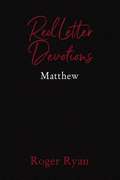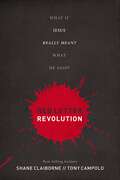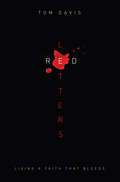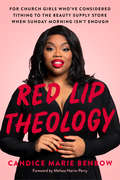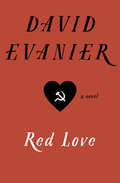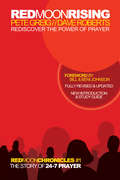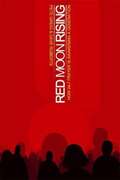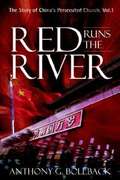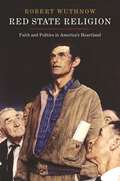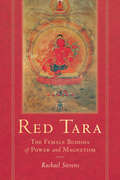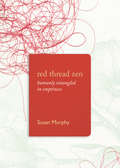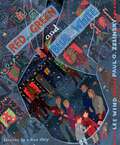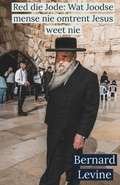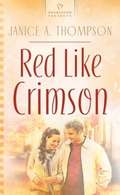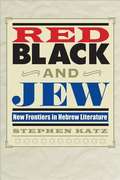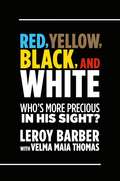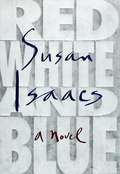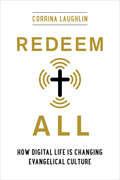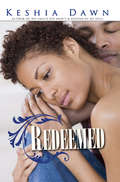- Table View
- List View
Red Letter Devotions: Matthew
by Roger RyanRed Letter Devotions are a series of devotionals from the book of Matthew.I&’ve titled them Red Letters, because that is the focus of each day&’s devotional.Jesus is the word and all scripture is God breathed, so every bit of scripture is the voice of God. In this devotional my prayer is that everyone who reads it will focus on the words that Jesus spoke while walking with His disciples, and that we too would become disciples of the living Christ.Each devotional centers around a passage of scripture, but I would encourage the reader to start each devotional by asking the Holy Spirit to lead them into the scriptures and take the time to read the larger portion of the passage.This devotional has been designed as a prayer journal so you can write down what the Lord is speaking to you each day. You may even want to go through these passages yearly and write down your thoughts each time. This could be the added blessing of seeing your spiritual journey over a period of time.
Red Letter Revolution: What If Jesus Really Meant What He Said?
by Shane Claiborne Tony CampoloFor all the Christians facing conflict between JesusÆ words and their own lives, for all the non-Christians who feel they rarely see JesusÆ commands reflected in the choices of his followers, Red Letter Revolution is a blueprint for a new kind of Christianity, one consciously centered on the words of Jesus, the BibleÆs ôred letters.öFramed as a captivating dialogue between Shane Claiborne, a progressive young evangelical, and Tony Campolo, a seasoned pastor and professor of sociology, Red Letter Revolution is a life-altering manifesto for skeptics and Christians alike. It is a call to a lifestyle that considers first and foremost JesusÆ explicit, liberating message of sacrificial love.Shane and Tony candidly bring the words of Jesus to bear on contemporary issues of violence, community, Islam, hell, sexuality, civil disobedience, and twenty other critical topics for people of faith and conscience today. The resulting conversations reveal the striking truth that Christians guided unequivocally by the words of Jesus will frequently reach conclusions utterly contrary to those of mainstream evangelical Christianity.If the Jesus who speaks to you through the Gospels is at odds with the Christian culture you know, if you have ever wanted to stand up and say, ôI love Jesus, but thatÆs not me,ö Red Letter Revolution will prove that you are not aloneùyou may have been a Red Letter Christian all along.Endorsements:ôThis book, by a young and an elderly Christian, will help you decide how we Christians could change the world if we took the æred letterÆ words of Jesus literally and seriously.ö ùPresident Jimmy CarterôIn Red Letter Revolution the uncompromised truth of Jesus' teachings are given voice by two modern-day Christian leaders who do more than preach this Good News. They walk the talk and lead the way.ö ùArchbishop Desmond TutuôI started reading this book and couldn't stop. . . . Thank you, Tony and Shane. Thank you for this book. May the movement spread around the world.ö ùAbuna Elias Chacour,?Melkite Catholic Archbishop of GalileeôRed Letter Revolution is an adrenaline-producing conversation with prophetic bite.ö ùEugene H. Peterson, author of The Message BibleôI cannot over-emphasize or exaggerate the richness of this book.ö ùPhyllis Tickle, author of Emergence ChristianityôIn this courageous and well crafted book, we have a return to the core message of the Gospel from two Christians who first tried to live it themselvesùand only then spoke." ùFr. Richard Rohr, O.F.M., Center for Action and ContemplationôShane Claiborne and Tony Campolo are two of the most significant prophetic voices in the Christian world.ö ùRabbi Michael Lerner, editor of Tikkun Magazine (tikkun.org)ôThis is a must-read book for anyone who is seeking to take JesusÆ call on their lives seriously.ö ùJim Wallis, founder and editor of Sojourners magazineôIf you ever wished you could eavesdrop on a conversation with two of the world's most interesting and inspiring Christians, just turn to page one.ö ùBrian D. McLaren, author/speaker (brianmclaren.net)
Red Letters
by Tom Davis"I was hungry and you gave me no food, I was thirsty and you gave me no drink, I was a stranger and you did not welcome me, naked and you did not clothe me, sick and in prison and you did not visit me."?Matthew 25:42-43 ESVIn many Bibles, Christ's words are set apart with a red font. It should be obvious, but this distinction helps remind us that when God becomes Man and that Man speaks--it's probably something we cannot afford to miss.So why doesn't the church take these "red letters" to heart? Why aren't we doing more to be Christ's hands and feet to the poor, the disenfranchised, the weary, the ill, the fatherless, the prisoners? It's all there--in red letters. Why has the Church shirked its responsibilities, leaving the work to be done by governments, rock stars, and celebrities?The Gospel wasn't only meant to be read--it was meant to be lived. From the HIV crisis in Africa to a single abused and lonely child in Russia, the Church must seize the opportunity to serve with a radical, reckless abandon. Author Tom Davis offers both challenge and encouragement to get involved in an increasingly interconnected, desperate modern world.
Red Lip Theology: For Church Girls Who've Considered Tithing to the Beauty Supply Store When Sunday Morning Isn't Enough
by Candice Marie BenbowA moving essay collection promoting freedom, self-love, and divine wholeness for Black women and opening new levels of understanding and ideological transformation for non-Black women and allies&“Candice Marie Benbow is a once-in-a-generation theologian, the kind who, having ground dogma into dust with the fine point of a stiletto, leads us into the wide-open spaces of faith.&”—Brittney Cooper, author of Eloquent Rage and co-editor of The Crunk Feminist Collection Blurring the boundaries of righteous and irreverent, Red Lip Theology invites us to discover freedom in a progressive Christian faith that incorporates activism, feminism, and radical authenticity. Essayist and theologian Candice Marie Benbow&’s essays explore universal themes like heartache, loss, forgiveness, and sexuality, and she unflinchingly empowers women who struggle with feeling loved and nurtured by church culture. Benbow writes powerfully about experiences at the heart of her Black womanhood. In honoring her single mother&’s love and triumphs—and mourning her unexpected passing—she finds herself forced to shed restrictions she&’d been taught to place on her faith practice. And by embracing alternative spirituality and womanist theology, and confronting staid attitudes on body positivity and LGBTQ+ rights, Benbow challenges religious institutions, faith leaders, and communities to reimagine how faith can be a tool of liberation and transformation for women and girls.
Red Love: A Novel
by David EvanierA brilliant tragicomedy based on the most infamous espionage trial of the twentieth centuryThirty years after they walked hand in hand to the electric chair, sentenced to die for giving the gift of the atom bomb to the Soviet Union, Solomon and Dolores Rubell are the targets of a new investigation—conducted not by the FBI, or some paranoid Senate subcommittee, but by Gerald Lerner, boyhood Communist and author of such classic chronicles of the American Jewish experience as Hot Pastrami Sandwich and Kosher and Topless. What does Gerald hope to find, all these years later, by placing ads in the Jewish Daily Forward and Screw seeking former Soviet spies willing to chat?The short answer: His sanity.With a gleam in its eye and tenderness in its heart, David Evanier&’s irreverent and incisive novel peers into one of the darkest chapters in American history—the execution of Julius and Ethel Rosenberg on charges of spying for the Soviet Union. Because, as Suzie Sizzle—great-niece of Dolly and Solly Rubell and star of a &“goodly number&” of hardcore films—explains to Gerald, this is not really a story about death, despite its gloomy ending. It is a story about love—the true love two proud Jewish underdogs had for each other, and the misguided love an entire generation of American leftists had for a political system whose grand promises masked terrible, irreconcilable truths.They say love will make you do crazy things. So, too, will Communism.
Red Moon Rising
by Pete Greig Dave RobertsFrom the Upper Room of Pentecost to Azusa Street in Los Angeles, God has used prayer movements throughout history to change the world. Over fifteen years ago, a group of students gathered for a prayer vigil in Chichester, England--and the prayers they started haven't stopped. Out of that first meeting came 24-7 Prayer: an international movement of prayer, mission, and justice that has reached Chinese underground churches, Indian slums, Papua New Guinea jungles, ancient English cathedrals, and even a brewery in Missouri.Red Moon Rising is the story of how that movement continues today--and how each of us can be a part of the miracles God is doing through a new generation.
Red Moon Rising: How 24-7 Prayer Is Awakening a Generation
by Pete Greig Dave RobertsIn 1999 a single, unsuspecting prayer room in England began to spontaneously multiply, touching 46 nations and millions of lives within a matter of months. Every minute since that moment has been filled with unbroken (24-7) prayer, everywhere from the U S Naval Academy and the slums of Delhi to a Swiss skate park and a German punk festival. This movement of prayer is generating miracles, new monasteries and missions deep into the heart of the postmodern culture. "Red Moon Rising will also look at the history of the church showing that 24-7 prayer is not a new model of prayer but has been deployed by God down through generations.
Red Runs the River: The Story of China's Persecuted Church
by Anthony G. BollbackThis is a book born of passion; passion that Anthony Bollback has for the Chinese people. This is a wonderful work that will grab your attention and capture your heart. -Dr. David F. Presher, Vice President for Advancement, The Christian and Missionary Alliance. Since the Communist takeover, every missionary in China has lived with two kinds of pain. The first, leaving a part of themselves behind in that beloved land, and second, the agony of soul in knowing of the persecuted church that must remain. Anthony Bollback, with sensitive insight and skill, has shown us another side of the story: the story of how that church has survived in triumph. The reader will be deeply moved with this account. Though by necessity fiction, it is exciting and historically factual. Read it and weep--and laugh--and rejoice. -Dr. Edwin W. Kilbourne, President at large, OMS International, A China Hand. Life-changing in its challenges and adventurous in its presentation, Red Runs the River masterfully reveals genuine human aspirations, concerns, and longings in the lives of Meiling and Anching. This book will capture your every emotion. -Dr. Mark T. O'Farrell, District Superintendent, The Christian and Missionary Alliance. Readers of this book will feel the heartbeat of that great nation portrayed in real conditions and characters captured in an engrossing drama. -Dr. Wayne Frair Ph.D. Former Chairman of the Biology Department, Kings College. Through the horrors of war and intense and almost unbelievable persecution for their faith in Christ, the characters in this novel--all composites of people known to the author-display enduring perseverance and courage. The underlying truth of each fictional episode makes this book much more than mere fiction. It is the gripping story of real people who would not recant their faith despite the most traumatizing conditions. Truly the gates of hell could not overcome China's courageous believers of Jesus Christ.
Red Sky in Mourning (Helen Bradley Mysteries, #3)
by Patricia H. RushfordHelen Bradley's latest writing assignment takes her away from her new husband to a charming coastal town on the Long Beach Peninsula of Washington State, where she's to finish assembling a regional travel guide. Arriving at the quaint bed and breakfast where she will stay for the next two weeks, Helen learns why the guidebook's original author couldn't complete the project. She's dead, and Helen's host at the bed and breakfast insists it was writing the guidebook that got her killed. Helen suspects that Isabelle stumbled upon some illegal activity, and an accident was staged to keep her quiet. And when a local fisherman who may know the mystery behind Isabelle's death disappears at sea, Helen teams up with a Coast Guard investigator to find some answers.
Red Star, Crescent Moon: A Muslim-Jewish Love Story
by Robert A. RosenstoneAn international film festival sparks a cross-cultural romance sparks in this novel of cultural history, ethnic tensions, and the power of love.Aisha and Benjamin meet at a film festival in Spain, and the instant attraction hits them both like a lightning bolt. She is a documentary filmmaker, and he is a historian. She is a Muslim, and he is a Jew. And as they get closer, the misunderstanding between them, and the tensions between their two worlds, escalates to dizzying extremes. Red Star, Crescent Moon mixes contemporary and the historical worlds in a bold tale of clashing cultures. It is a tale of new romance and ancient conflicts, where pop culture and political violence exist side by side. The romance of Aisha and Benjamin is set against the backdrop of a Hollywood epic in production, a movie megastar with seductive intentions, and terrorists who wish to reclaim Spain for Islam.
Red State Religion: Faith and Politics in America's Heartland
by Robert WuthnowWhat Kansas really tells us about red state AmericaNo state has voted Republican more consistently or widely or for longer than Kansas. To understand red state politics, Kansas is the place. It is also the place to understand red state religion. The Kansas Board of Education has repeatedly challenged the teaching of evolution, Kansas voters overwhelmingly passed a constitutional ban on gay marriage, the state is a hotbed of antiabortion protest—and churches have been involved in all of these efforts. Yet in 1867 suffragist Lucy Stone could plausibly proclaim that, in the cause of universal suffrage, "Kansas leads the world!" How did Kansas go from being a progressive state to one of the most conservative?In Red State Religion, Robert Wuthnow tells the story of religiously motivated political activism in Kansas from territorial days to the present. He examines how faith mixed with politics as both ordinary Kansans and leaders such as John Brown, Carrie Nation, William Allen White, and Dwight Eisenhower struggled over the pivotal issues of their times, from slavery and Prohibition to populism and anti-communism. Beyond providing surprising new explanations of why Kansas became a conservative stronghold, the book sheds new light on the role of religion in red states across the Midwest and the United States. Contrary to recent influential accounts, Wuthnow argues that Kansas conservatism is largely pragmatic, not ideological, and that religion in the state has less to do with politics and contentious moral activism than with relationships between neighbors, friends, and fellow churchgoers.This is an important book for anyone who wants to understand the role of religion in American political conservatism.
Red Stilettos
by Ruth JosephThis sensational collection of quality short stories is perfect for the mainstream fiction market. The writing style is deft and stylish but accessible on many levels making it attractive to those buying for book groups and readers who enjoy quality short fiction.Ruth Joseph lives in Cardiff, Wales where she is part of the strong Jewish community. She has a strong, evovative voice which speaks directly to the reader about guilt, love and food. Her work has previously been published by Honno, Parthian and Loki.
Red Stilettos
by Ruth JosephThis sensational collection of quality short stories is perfect for the mainstream fiction market. The writing style is deft and stylish but accessible on many levels making it attractive to those buying for book groups and readers who enjoy quality short fiction.Ruth Joseph lives in Cardiff, Wales where she is part of the strong Jewish community. She has a strong, evovative voice which speaks directly to the reader about guilt, love and food. Her work has previously been published by Honno, Parthian and Loki.
Red Tara: The Female Buddha of Power and Magnetism
by Rachael StevensA complete introduction to the Buddhist goddess Tara, with special emphasis on her form as Red Tara.Tara is one of the most celebrated goddesses in the Buddhist world, representing enlightened activity in the form of the divine feminine. She protects, nurtures, and helps practitioners on the path to enlightenment. Manifesting in many forms and in many colors to help beings, Tara's red form represents her powers of magnetization, subjugation, and the transformation of desire into enlightened activity. Red Tara has gained popularity in recent years with practitioners of Tibetan Buddhism worldwide. She is considered to be particularly powerful in times of plague and disharmony.This comprehensive overview focuses on the origins, forms, and practices of Tara, providing the reader with insightful information and inspirations relating to the goddess. Its second part focuses on Red Tara, a powerful and liberating form of Tara that is particularly important to connect with in a time of crisis. These chapters cover various forms of Red Tara found throughout the Tibetan Buddhist world, the particular qualities she represents, and how through prayers and meditation we can embody her principles and truly benefit beings. An accompanying appendix includes prayers, songs, and meditations on the goddess, enabling readers to directly connect with their compassionate enlightened nature through practices associated with this powerful Buddhist female deity.
Red Thread Zen: Humanly Entangled in Emptiness
by Susan MurphyLove, attachment, the passions, gender, carnality, birth, bodily being, mortality, belonging, suffering, hope, despair, personhood, imagination, vitality, the struggle to be fully human - how do these things dwell wholly in emptiness, how do we reconcile their vivid life with 'no-thingness'?The red (or 'vermilion') thread originally connoted the color of the silk undergarments courtesans were obliged to wear. Most spiritual traditions do their best to distance themselves as thoroughly as possible from such direct and intimate contact with the fact of impassioned human bodily being, if not to declare open war upon the flesh, and the female body that most plainly bears flesh into the world. Spirituality has trouble dealing with the fact that we arrive here covered in blood.But the red thread can never be cut. Why not? Why would no perfectly accomplished saint ever even dream of cutting it?Red Thread Zen will set out to explore every corner of the magnificent koan of being 'still attached to the red thread, or 'line of tears'. This is an argument against the bloodless and socially disengaged form of 'Buddhism' that is generally being gestated in the West, one that shades too readily into the blandest of bland self-help.
Red Velvet
by Sandra ByrdTwo teenage girls are united by their mothers' illnesses. In helping her mother accomplish everything on a childhood wish list, Quinn wonders if she's giving her mom permission to die. Her new friend's mother has hopes and dreams, too, along with a secret they finally must discuss.
Red and Green and Blue and White
by Lee WindOn a block dressed up in Red and Greenone house shone Blue and White.It's a holiday season that both Isaac, whose family is Jewish, and Teresa, whose family is Christian, have looked forward to for months! They've been counting the days, playing in the snow, making cookies, drawing (Teresa) and writing poems (Isaac). They enjoy all the things they share, as well as the things that make them different.But when Isaac's window is smashed in the middle of the night, it seems like maybe not everyone appreciates "difference."Inspired by a true story, this is a tale of a community that banded together to spread light.
Red die Jode: Wat Joodse mense nie omtrent Jesus weet nie
by Bernard LevineHoe hartseer en wat 'n verskriklike tragedie is dit, dat die Joodse nasie, die "Mense van die Boek", nie in Jesus glo nie. Die Jode is behep daarmee om die vele mens-gemaakte wette en tradisies - wat die Rabbis saamgestel het - te volg, te hou en te gehoorsaam. Omdat die bloed offers van die Ou Testament mee weggedoen is en nie langer waargeneem word nie, kan Jode nie hulle sondes skoongewas en vergewe kry sonder bloed nie. Daar is so baie omtrent Jesus wat die Jode nooit gehoor het of nie weet nie.... Sal jy vir die Jode van Jesus vertel?
Red like Crimson
by Janice A. ThompsonWhen Adrianne found out she was pregnant eight years ago, she made the decision to leave Bible school and raise her child alone. Staying would have prevented her boyfriend from fulfilling his God-appointed mission in life. But every day since, she has regretted her decision. Chris-rejected, confused, and heartbroken-finished school and soon found himself in Nicaragua, loving life as a missionary. But the void left by Adrianne's unexplained departure remains. When Chris returns to the States for a friend's wedding, is his unexpected meeting with Adrianne a coincidence or a "God incidence?" Can they put aside the past and embrace a future together as a family?
Red, Black, and Jew: New Frontiers in Hebrew Literature
by Stephen KatzBetween 1890 and 1924, more than two million Jewish immigrants landed on America's shores. The story of their integration into American society, as they traversed the difficult path between assimilation and retention of a unique cultural identity, is recorded in many works by American Hebrew writers. Red, Black, and Jew illuminates a unique and often overlooked aspect of these literary achievements, charting the ways in which the Native American and African American creative cultures served as a model for works produced within the minority Jewish community. Exploring the paradox of Hebrew literature in the United States, in which separateness, and engagement and acculturation, are equally strong impulses, Stephen Katz presents voluminous examples of a process that could ultimately be considered Americanization. Key components of this process, Katz argues, were poems and works of prose fiction written in a way that evoked Native American forms or African American folk songs and hymns. Such Hebrew writings presented America as a unified society that could assimilate all foreign cultures. At no other time in the history of Jews in diaspora have Hebrew writers considered the fate of other minorities to such a degree. Katz also explores the impact of the creation of the state of Israel on this process, a transformation that led to ambivalence in American Hebrew literature as writers were given a choice between two worlds. Reexamining long-neglected writers across a wide spectrum, Red, Black, and Jew celebrates an important chapter in the history of Hebrew belles lettres.
Red, Brown, Yellow, Black, WhiteWho's More Precious In God's Sight?: A Call for Diversity in Christian Missions and Ministry
by Velma Maia Thomas Leroy BarberAfter more than two decades in urban missions, Leroy Barber discovered a disturbing trend: The virtual absence of people of color in the mission field has created a widening racial disconnect, to the point that Christian ministries can no longer relate to the people they claim to serve. RED, YELLOW, BLACK AND WHITE highlights the historic patterns that have created racial discrepancies within ministries, sheds light on the diversification needed in church and missions, and offers constructive, clear-cut solutions to promote a diverse leadership. With grace, insider expertise, and insightful understanding, Barber explores one of the most sensitive issues facing today's Christian ministries, offering practical and comprehensive solutions for creating a more diverse future. ructive, clear-cut solutions for how to truly promote diverse leadership in urban missions and ministries, for the benefit of the organization and the community being served With grace, insider expertise and insightful historical understanding, Barber takes on one of the most sensitive issues facing today's Christian ministries, offering practical, comprehensive solutions for creating a more diverse future.
Red-Hot and Righteous: The Urban Religion of The Salvation Army
by Diane WinstonIn this engrossing study of religion, urban life, and commercial culture, Diane Winston shows how a (self-styled "red-hot") militant Protestant mission established a beachhead in the modern city. When The Salvation Army, a British evangelical movement, landed in New York in 1880, local citizens called its eye-catching advertisements "vulgar" and dubbed its brass bands, female preachers, and overheated services "sensationalist." Yet a little more than a century later, this ragtag missionary movement had evolved into the nation's largest charitable fund-raiser--the very exemplar of America's most cherished values of social service and religious commitment. Winston illustrates how the Army borrowed the forms and idioms of popular entertainments, commercial emporiums, and master marketers to deliver its message. In contrast to histories that relegate religion to the sidelines of urban society, her book shows that Salvationists were at the center of debates about social services for the urban poor, the changing position of women, and the evolution of a consumer culture. She also describes Salvationist influence on contemporary life--from the public's post-World War I (and ongoing) love affair with the doughnut to the Salvationist young woman's career as a Hollywood icon to the institutionalization of religious ideals into nonsectarian social programs. Winston's vivid account of a street savvy religious mission transformed over the decades makes adroit use of performance theory and material culture studies to create an evocative portrait of a beloved yet little understood religious movement. Her book provides striking evidence that, counter to conventional wisdom, religion was among the seminal social forces that shaped modern, urban America--and, in the process, found new expression for its own ideals.
Redeem All: How Digital Life Is Changing Evangelical Culture
by Corrina LaughlinRedeem All examines the surprising intersection of American evangelicalism and tech innovation. Corrina Laughlin looks at the evangelical Christians who are invested in imagining, using, hacking, adapting, and creating new media technologies for religious purposes. She finds that entrepreneurs, pastors, missionaries, and social media celebrities interpret the promises born in Silicon Valley through the framework of evangelical culture and believe that digital media can help them (to paraphrase Steve Jobs) put their own dent in the universe. Laughlin introduces readers to "startup churches" hoping to reach a global population, entrepreneurs coding for a deeper purpose, digital missionaries networking with mobile phones, and Christian influencers and podcasters seeking new forms of community engagement. Redeem All reveals how evangelicalism has changed as it eagerly adopts the norms of the digital age.
Redeemed
by Hannah Howell Sara Blayne Keshia DawnIt's no accident when Kenya Clark gets paired up with Keithe Morgan, the newest member of the divorce support group she leads at their church. The pastor has been trying to get Kenya married off for some time now. Unfortunately, Kenya is still grappling with her past, and she isn't quite ready to enter into something new.Keithe, on the other hand, is recently divorced and ready to move on. He hasn't given up on love; he still believes he'll find a soul mate. When he starts pushing hard to get to know Kenya better, she feels the connection and panics. The only way she knows to distance herself is to start dating his friend. Keithe is puzzled. Why would she choose his friend, whose issues make him far from the most eligible bachelor? When Keithe learns the truth about her past, will he still want to hold on and work toward a future together?Redeemed is about having the strength to accept people right where they are.
